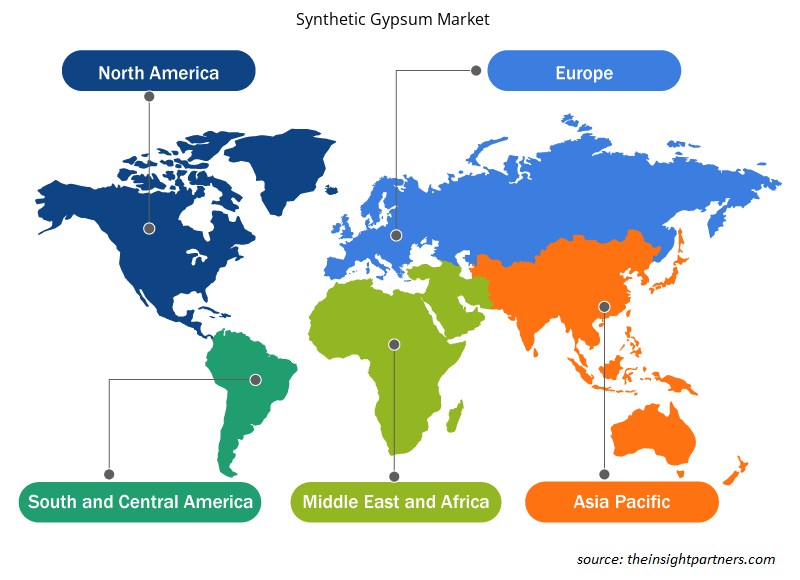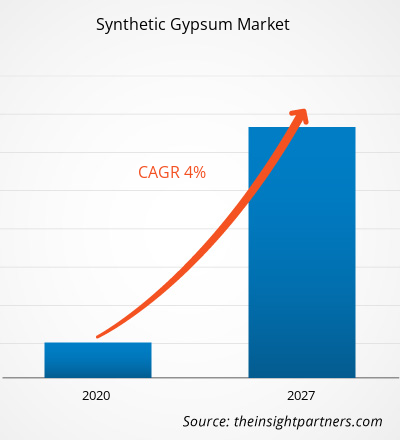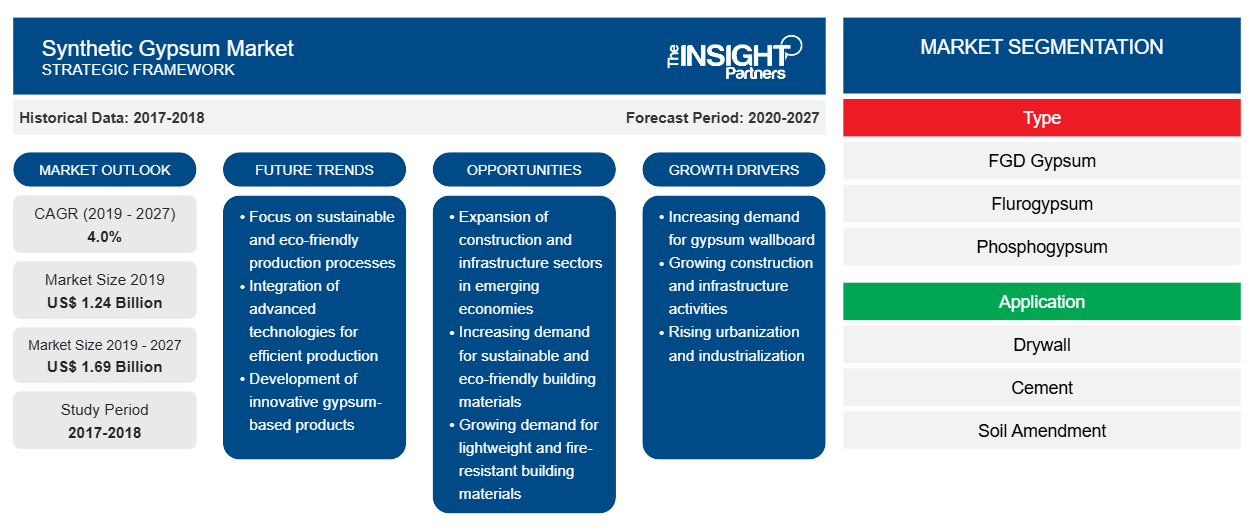[Forschungsbericht] Der globale Markt für synthetischen Gips wurde im Jahr 2019 auf 1.244,02 Millionen US-Dollar geschätzt und soll bis 2027 1.693,72 Millionen US-Dollar erreichen; von 2020 bis 2027 wird ein durchschnittliches jährliches Wachstum von 4,0 % erwartet.
Synthetischer Gips wird hauptsächlich in der Bau- und Landwirtschaftsindustrie verwendet. Das Wachstum der Bauindustrie weltweit hat die Nachfrage nach dekorativen Strukturen und Trockenbauwänden erhöht, was wiederum die Nachfrage nach synthetischem Gips ankurbelt. Darüber hinaus fördert die Verwendung von synthetischem Gips als Füllstoff im Zementherstellungsprozess das Wachstum des Marktes für synthetischen Gips.
Im Jahr 2019 hatte Nordamerika den größten Anteil am globalen Markt für synthetischen Gips. Das Wachstum des nordamerikanischen Marktes ist auf die wachsende Bauindustrie in den USA und die Entstehung verschiedener FGD-Systemunternehmen in Nordamerika zurückzuführen. Aufgrund der zunehmenden Urbanisierung und Industrialisierung nehmen die Bauaktivitäten in der Region zu. Dies stimuliert die Nachfrage nach Stadterneuerungsprojekten, was wiederum die Nachfrage nach synthetischem Gips ankurbelt, der zur Herstellung von Zement, Trockenbau und dekorativen Strukturen verwendet wird.
Der COVID-19-Ausbruch wirkt sich aufgrund von Lockdowns, Reiseverboten und Betriebsschließungen negativ auf die Wirtschaft und Industrie in verschiedenen Ländern aus. Die globale Chemie- und Materialindustrie ist eine der wichtigsten Branchen, die unter ernsthaften Störungen wie Lieferkettenunterbrechungen, Absagen von Technologieveranstaltungen und Büroschließungen leidet. China beispielsweise ist das globale Produktionszentrum und der größte Rohstofflieferant für verschiedene Branchen und gleichzeitig eines der am schlimmsten betroffenen Länder. Die Schließung verschiedener Werke und Fabriken in China schränkt die globalen Lieferketten ein und stört die Produktionsaktivitäten, Lieferpläne und den Verkauf verschiedener Chemikalien und Materialien. Verschiedene Unternehmen haben bereits mögliche Verzögerungen bei Produktlieferungen und einen Einbruch der zukünftigen Verkäufe ihrer Produkte angekündigt. Darüber hinaus behindern die von Ländern in Europa, Asien und Nordamerika verhängten globalen Reiseverbote die Möglichkeiten für Geschäftskooperationen und Partnerschaften. All diese Faktoren behindern die Chemie- und Materialindustrie und wirken somit als hemmende Faktoren für das Wachstum verschiedener Märkte, die mit dieser Branche verbunden sind.
Passen Sie diesen Bericht Ihren Anforderungen an
Sie erhalten kostenlos individuelle Anpassungen an jedem Bericht, einschließlich Teilen dieses Berichts oder einer Analyse auf Länderebene, eines Excel-Datenpakets sowie tolle Angebote und Rabatte für Start-ups und Universitäten.
-
Holen Sie sich die wichtigsten Markttrends aus diesem Bericht.Dieses KOSTENLOSE Beispiel umfasst eine Datenanalyse von Markttrends bis hin zu Schätzungen und Prognosen.
Markteinblicke
Steigende Nachfrage aus der Bauindustrie
Die Nachfrage nach synthetischem Gips ist in der Bauindustrie gestiegen. In der Bauindustrie wird synthetischer Gips hauptsächlich als Füllstoff für Zement und Putz verwendet, um deren Festigkeit zu erhöhen und die Abbindezeit des Betons zu verkürzen. Er wird auch zur Herstellung von dekorativen Platten und Gips verwendet. REA-Gips, eine Art synthetischen Gipses, wird in der Bauindustrie hauptsächlich zur Herstellung von Zement, Trockenbauwänden und Gips verwendet. REA-Gips ist grundsätzlich recycelbar und wird daher von den Herstellern hauptsächlich verwendet. Gips wird hauptsächlich zur Herstellung von dekorativen Platten, Strukturen und Skulpturen verwendet. Die Nachfrage nach diesen Strukturen und Skulpturen steigt in der Bauindustrie, was zu einer steigenden Nachfrage nach synthetischem Gips führt. Die Regierungen vieler Entwicklungsländer konzentrieren sich auf die Entwicklung und Verbesserung ihrer Infrastruktur und führen viele Reformen und Vorschriften ein, die dazu beitragen werden, die Immobilien- und Infrastrukturbranche anzukurbeln. All diese Vorschriften und Reformen dürften sich positiv auf die Bauwirtschaft auswirken und im Prognosezeitraum zu einer Steigerung der Nachfrage nach synthetischem Gips führen.paris. FGD gypsum, which is one of the types of synthetic gypsum, is mainly used in the construction industry to manufacture cement, drywall, and plaster of paris. FGD gypsum is basically recyclable in nature and thus, is mostly used by the manufacturers. Plaster of Paris is basically used for making decorative panels, structures, and sculptures. The demand for these structures and sculptures are increasing in the construction industry, which is leading to an increase in the demand of synthetic gypsum. The governments of many developing countries are focusing on developing and improving their infrastructure and are introducing many reforms and regulations that will help in boosting the real-estate and infrastructure industries. All these regulations and reforms are expected to have a positive impact on the construction industry, which would boost the demand for synthetic gypsum in the forecast period.
Typ-Einblicke
Der Markt für synthetischen Gips ist nach Typ in REA-Gips, Flurgips, Phosphogips, Citrogips und andere unterteilt. Das Segment REA-Gips war 2019 mit dem größten Anteil Marktführer.FGD gypsum, Flurogypsum, Phosphogypsum, Citrogypsum, and Others. The FGD gypsum segment led the market with the largest share in 2019. REA-Gips ist im Wesentlichen der Gips, der aus Rauchgasentschwefelungsanlagen gewonnen wird. Der Schwefel wird größtenteils aus dem Rauchgas entfernt, was mithilfe von Kalk in der Rauchgasentschwefelungsanlage erfolgen kann. REA-Gips hat größtenteils die gleiche chemische Identität wie natürlicher Gips und gilt als Gips mit höherer Reinheit. Die Verwendung von REA-Gips gilt als ökologisch vorteilhaft. REA-Gips wird in der Landwirtschaft verwendet und kann unter Boden- und hydrogeologischen Bedingungen zum Zweck der Bodenerhaltung und des industriellen Materialrecyclings verwendet werden. Der Prozess, durch den REA-Gips hergestellt wird, ist umweltfreundlich und bietet eine ökologische Quelle für reinen Gips. REA-Gips wird in verschiedenen Prozessen wie Zementherstellung, Wasseraufbereitung, Glasherstellung, Bergbauanwendungen, Gipsplattenprodukten, Straßenbau und Landwirtschaft verwendet. Er kann auch als Nährstoffquelle für Nutzpflanzen verwendet werden. gypsum is basically the gypsum obtained from the flue gas desulfurization systems. The sulfur is mostly removed from the flue gas, which can be done through the help of lime in the flue gas desulfurization system. The FGD gypsum mostly has the same chemical identity as that of a natural gypsum, and it is considered as a gypsum of greater purity. The use of FGD gypsum is considered as ecologically beneficial. FGD gypsum has agricultural applications and can be used in soil and hydrogeologic conditions for the purpose of soil conservation and industrial material recycling. The process through which FGD gypsum is manufactured is eco-friendly and provides an ecological source of pure gypsum. FGD gypsum has various applications in processes such as cement production, water treatment, glass making, mining applications, gypsum panel products, highway construction, and agriculture. It can also be used as a source of nutrition for crops.
Einige wichtige Marktteilnehmer auf dem Markt für synthetischen Gips sind Drax Group PLC, American Gypsum, USG Corporation, Larargeholcim, Travancore Titanium Products Limited, Knauf Gips KG, Transparent Technologies Limited, BauMineral GMBH, Steag GMBH und Boral. Wichtige Marktteilnehmer konzentrieren sich auf Strategien wie Fusionen und Übernahmen sowie Produkteinführungen, um ihre geografische Präsenz und Kundenbasis weltweit zu erweitern. Drax Group PLC, American Gypsum, USG Corporation, Larargeholcim, Travancore Titanium Products Limited, Knauf Gips KG, Transparent Tehcnologies Limited, BauMineral GMBH, Steag GMBH, and Boral. Major players in the market are focusing on strategies such as mergers and acquisitions, and product launches to expand their geographical presence and consumer base globally.
Regionale Einblicke in den Markt für synthetischen Gips
Die regionalen Trends und Faktoren, die den Markt für synthetischen Gips im Prognosezeitraum beeinflussen, wurden von den Analysten von Insight Partners ausführlich erläutert. In diesem Abschnitt werden auch die Marktsegmente und die Geografie für synthetischen Gips in Nordamerika, Europa, im asiatisch-pazifischen Raum, im Nahen Osten und Afrika sowie in Süd- und Mittelamerika erörtert.

- Erhalten Sie regionale Daten zum Markt für synthetischen Gips
Umfang des Marktberichts über synthetischen Gips
| Berichtsattribut | Details |
|---|---|
| Marktgröße im Jahr 2019 | 1,24 Milliarden US-Dollar |
| Marktgröße bis 2027 | 1,69 Milliarden US-Dollar |
| Globale CAGR (2019 - 2027) | 4,0 % |
| Historische Daten | 2017-2018 |
| Prognosezeitraum | 2020–2027 |
| Abgedeckte Segmente |
Nach Typ
|
| Abgedeckte Regionen und Länder |
Nordamerika
|
| Marktführer und wichtige Unternehmensprofile |
|
Dichte der Marktteilnehmer für synthetischen Gips: Die Auswirkungen auf die Geschäftsdynamik verstehen
Der Markt für synthetischen Gips wächst rasant, angetrieben durch die steigende Nachfrage der Endverbraucher aufgrund von Faktoren wie sich entwickelnden Verbraucherpräferenzen, technologischen Fortschritten und einem größeren Bewusstsein für die Vorteile des Produkts. Mit steigender Nachfrage erweitern Unternehmen ihr Angebot, entwickeln Innovationen, um die Bedürfnisse der Verbraucher zu erfüllen, und nutzen neue Trends, was das Marktwachstum weiter ankurbelt.
Die Marktteilnehmerdichte bezieht sich auf die Verteilung der Firmen oder Unternehmen, die in einem bestimmten Markt oder einer bestimmten Branche tätig sind. Sie gibt an, wie viele Wettbewerber (Marktteilnehmer) in einem bestimmten Marktraum im Verhältnis zu seiner Größe oder seinem gesamten Marktwert präsent sind.
Die wichtigsten auf dem Markt für synthetischen Gips tätigen Unternehmen sind:
- Drax Group PLC
- Amerikanischer Gips
- USG Corporation
- Larargeholcim
- Travancore Titanium Products Limited
Haftungsausschluss : Die oben aufgeführten Unternehmen sind nicht in einer bestimmten Reihenfolge aufgeführt.

- Überblick über die wichtigsten Akteure auf dem Markt für synthetischen Gips
Bericht-Spotlights
- Fortschrittliche Branchentrends auf dem globalen Markt für synthetischen Gips helfen den Akteuren bei der Entwicklung wirksamer langfristiger Strategien
- In Industrie- und Entwicklungsländern angewandte Strategien für Unternehmenswachstum
- Quantitative Analyse des globalen Marktes für synthetischen Gips von 2017 bis 2027
- Schätzung der Nachfrage nach synthetischem Gips in verschiedenen Branchen
- PEST-Analyse zur Veranschaulichung der Wirksamkeit der in der Branche tätigen Käufer und Lieferanten bei der Vorhersage des Marktwachstums
- Aktuelle Entwicklungen zum Verständnis des Wettbewerbsmarktszenarios und der Nachfrage nach synthetischem Gips
- Markttrends und -aussichten in Verbindung mit Faktoren, die das Wachstum des synthetischen Gipsmarktes vorantreiben und bremsen
- Entscheidungsprozess durch das Verständnis von Strategien, die das kommerzielle Interesse im Hinblick auf das globale Wachstum des synthetischen Gipsmarktes untermauern
- Marktgröße für synthetischen Gips an verschiedenen Marktknoten
- Detaillierte Übersicht und Segmentierung des globalen Marktes für synthetischen Gips sowie seiner Dynamik in der Branche
- Marktgröße für synthetischen Gips in verschiedenen Regionen mit vielversprechenden Wachstumschancen
Markt für synthetischen Gips nach Typ
- REA-Gips
- Flurgips
- Phosphogips
- Zitronengips
- Sonstiges
Synthetischer Gipsmarkt, nach Anwendung
- Trockenbau
- Zement
- Bodenverbesserung
- Zahnmedizin
- Wasseraufbereitung
- Sonstiges
Firmenprofile
- Drax Group PLC
- Amerikanischer Gips
- USG Corporation
- Larargeholcim
- Travancore Titanium Products Limited
- Knauf Gips KG
- Transparent Technologies Limited
- BauMineral GMBH
- Steag GMBH
- Boral
- Historische Analyse (2 Jahre), Basisjahr, Prognose (7 Jahre) mit CAGR
- PEST- und SWOT-Analyse
- Marktgröße Wert/Volumen – Global, Regional, Land
- Branchen- und Wettbewerbslandschaft
- Excel-Datensatz
Aktuelle Berichte
Erfahrungsberichte
Grund zum Kauf
- Fundierte Entscheidungsfindung
- Marktdynamik verstehen
- Wettbewerbsanalyse
- Kundeneinblicke
- Marktprognosen
- Risikominimierung
- Strategische Planung
- Investitionsbegründung
- Identifizierung neuer Märkte
- Verbesserung von Marketingstrategien
- Steigerung der Betriebseffizienz
- Anpassung an regulatorische Trends























 Kostenlose Probe anfordern für - Markt für synthetischen Gips
Kostenlose Probe anfordern für - Markt für synthetischen Gips